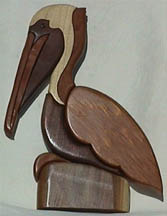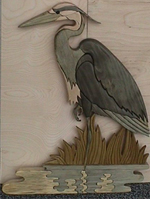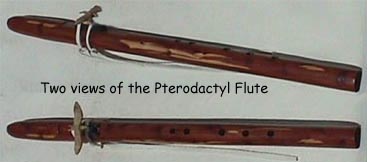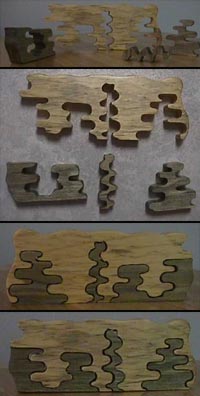Intarsia, Native American Flutes, and Wooden Puzzles
Intarsia
"Intarsia" is an ancient Italian woodworking method for making 3-dimensional pictures in wood. Often these woods are between 1/4" and 1 3/4" thick, and can be of several different species in the same piece. The colors and grain patterns on the wood are carefully chosen to enhance the design. When pictures are made with veneers, it is called "marquetry". The term "parquetry" is used for pictures made of veneer using geometric designs rather than a scene or identifiable object. For a more detailed history of intarsia, click here.

If you enjoy putting jigsaw puzzles together, you'll see how much fun this woodworking pastime can be. And it doesn't have to have a lot of parts to it to look good. For example, the pelican here was the first one that I ever did, in a WoodCraft class, from a pattern in a book by Judy Gale Roberts. It has only 9 pieces to work with, all but one were easy to sand, shape and fit, but that was because I had never used a scroll saw before and my cutting of that one piece was atrocious! As you can see, unlike the frustrations of a standard cardboard jigsaw puzzle, if the pieces don't fit, you can sand them down and MAKE them fit!
Of course, you can design your own if you don't find what you like in the pattern books. The background of this page is one that I designed myself from the standard southwestern motif of Kokopelli. It uses 7 different exotic woods, has leather trim, a tiny ebony Kokopelli fetish that is no larger than 1/2 my thumbnail sitting on the Bois d'Arc flute, and was a project of "firsts":
- First intarsia project since the class;
- First one of my own design;
- First attempt at an inside cut;
- First attempt at dovetail-like joints;
- First one using non-wood accents (Leather);
- First attempt at using woods of different thickness;
- First attempt at not attaching pieces to a backing;
- And my first multi-exotic wood piece.
If you would like to see the bois d'arc flute and ebony fetish that I based my intarsia pattern on, click here.

This 70-piece Great Blue Heron intarsia has been a real challenge! From a pattern by Judy Gale Roberts, this design called for Western Red Cedar, but a BLUE Heron is not RED, so, since I use natural woods (no stain), the search began for bluish-grey wood. I finally found Blue Stain Pine, (described in the puzzle section below) and so here is the Heron!
Click here to see the carved detail of the foot, and the tiny knot on the beak defining the nostril.
Native American Flutes
The Kokopelli intarsia now resides at the home of my dear friend, Kokopelli the Flute Crafter, whom you can contact from this page if you are interested in handcrafted Native American flutes. His work is the best that I have ever seen, and he is one of the extreme few who also crafts the hauntingly lovely tuned Apache-style double flutes. In fact, here are some examples of his signed work that I currently own:
My Pterodactyl Flute - A One-of-a-Kind Delight
Sometimes wood, especially aromatic cedar, just cries out to be something spectacular, and when it works, it can be awesome!Terry carved this Pterodactyl Flute especially for me. If you look closely at the flute, you'll see at least SEVEN pterodactyls hiding among the knots and sapwood, depending on how you count them. It's really amazing.
 The side view shows 5 pterodactyls (not counting the fetish) with the larger sapwood image and the little one near the blowhole each having two interpretations.
The side view shows 5 pterodactyls (not counting the fetish) with the larger sapwood image and the little one near the blowhole each having two interpretations. And 3 pterodactyls can be seen in the top view, including the tiniest one on the flute. A ghostly 'dactyl hangs out on the opposite side. And there's an awesome set of knothole eyes with beak and crest, (approximately 4 inches long) on the back.


